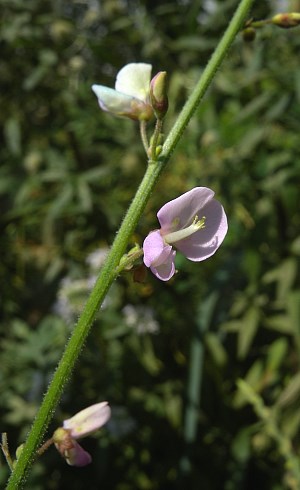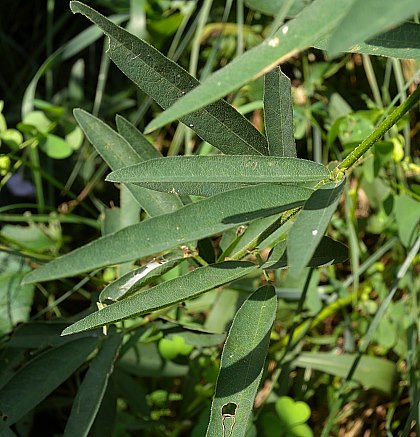 inflorescence is light to
medium green and hairy. Individual flowers
are about
¼" across, consisting of 5 petals that are white, pink, or rose-pink, a
short tubular calyx with 5 teeth, several stamens, and a pistil with a
single style. The
petals form an upper banner and 2 wings that enclose a keel; at the
base of the banner, there is a patch of pale yellow. The hairy calyx
varies from light green to purple. Each flower has a short slender
pedicel up to ¼" long. The blooming period occurs during mid- to late
summer and
lasts about 3-4 weeks. Usually, only a few flowers are in bloom at the
same time. There is no noticeable floral scent. The flowers are
replaced by flattened seedpods called 'loments' that consist of 1-3
segments with
convex upper and lower sides. The lower side of each segment
is more convex that the
upper side. The loments are pale green and covered with hooked hairs.
The loments have a tendency to break apart into individual segments;
each segment contains a single seed. The root system consists of a deep
taproot. This wildflower spreads by reseeding itself.
inflorescence is light to
medium green and hairy. Individual flowers
are about
¼" across, consisting of 5 petals that are white, pink, or rose-pink, a
short tubular calyx with 5 teeth, several stamens, and a pistil with a
single style. The
petals form an upper banner and 2 wings that enclose a keel; at the
base of the banner, there is a patch of pale yellow. The hairy calyx
varies from light green to purple. Each flower has a short slender
pedicel up to ¼" long. The blooming period occurs during mid- to late
summer and
lasts about 3-4 weeks. Usually, only a few flowers are in bloom at the
same time. There is no noticeable floral scent. The flowers are
replaced by flattened seedpods called 'loments' that consist of 1-3
segments with
convex upper and lower sides. The lower side of each segment
is more convex that the
upper side. The loments are pale green and covered with hooked hairs.
The loments have a tendency to break apart into individual segments;
each segment contains a single seed. The root system consists of a deep
taproot. This wildflower spreads by reseeding itself.Cultivation: The preference is full sun, dry conditions, and sandy soil. However, this wildflower will tolerate partial sun and either loamy or rocky soil. The root system adds nitrogen to the soil via symbiotic bacteria.
Range & Habitat: The native Sessile-Leaved Tick Trefoil is occasional in southern, west-central, and NE Illinois, while in the rest of the state it is rare or absent (see Distribution Map). Habitats include dry sand prairies and typical prairies, railroad prairies, dry sandy savannas and typical savannas, rocky open woodlands, limestone glades, and roadside embankments.
Faunal Associations: The flowers are cross-pollinated primarily by long-tongued bees, which collect pollen. These floral visitors include bumblebees, leaf-cutting bees (Megachile spp.), long-horned bees (Melissodes spp.), alkali bees (Nomia spp.), and others. Some insects feed on the foliage, flowers, or seeds of Sessile-Leaved Tick Trefoil and other species of this genus. This includes the caterpillars of several skippers, specifically: Achalarus lyciades (Hoary Edge), Epargyreus clarus (Silver-Spotted Skipper), Thorybes bathyllus (Southern Cloudywing), and Thorybes pylades (Northern Cloudywing). Other insect feeders include caterpillars of the butterflies Everes comyntas (Eastern Tailed Blue) and Strymon melinus (Gray Hairstreak), caterpillars of the moths Hypena scabra (Green Cloverworm) and Grapholita fana (Chesire Cat Moth), leaf-mining larvae of the Buprestid beetles Pachyschelus confusus and Pachyschelus laevigatus, larvae of the seed weevil Apion decoloratum, the thrips Echinothrips americanus and Neohydatothrips desmodianus, and the aphid Microparsus variabilis. There are also several leaf beetles that feed on tick trefoil species, specifically: Anomoea laticlavia (Clay-colored Leaf Beetle), Bassareus lituratus, Cerotoma trifurcata (Bean Leaf Beetle), Colaspis brunnea (Grape Colaspis), Cryptocephalus insertus, Odontota dorsalis (Locust Leaf Miner), Pachybrachis nigricornis, Pachybrachis othonus, Phyllecthris dorsalis, and Saxinis omogera.

Some vertebrate animals also feed on these plants. Both the Bobwhite Quail and Wild Turkey eat the seeds, while the White-Tailed Deer, Cottontail Rabbit, horses, cattle, and other mammalian herbivores readily consume the foliage. Because the hooked hairs of the loments can cling to clothing and fur, the seeds are distributed into new areas by humans and mammals.
Photographic Location: The wildflower garden of the webmaster in Urbana, Illinois.
Comments: Sessile-Leaved Tick Trefoil is one of the Desmodium spp. that is often found in prairies. It produces smaller and fewer flowers than another prairie species, Desmodium canadense (Showy Tick Trefoil). Sessile-Leaved Tick Trefoil can be distinguished from other species in this difficult genus by its more narrow leaflets (at least 3 times as long as across), very short petioles (¼" in length or less), and its narrow inflorescence (a simple raceme or sparingly branched panicle).